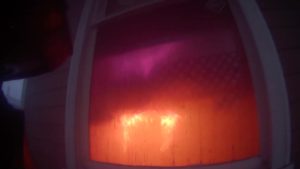Some takeaways from a recent live-fire training burn in a 2.5 story wood frame acquired structure….
Building layout and fire behavior:
This was a floor 2 bedroom fire with a large, vaulted exposure room. The ceiling sloped down towards the fire room. You can see early on how the exposure room stays relatively clear and visible because the vaulted overhead is still filling up with smoke and has plenty of space to fill before the thermal layer creeps lower in the room. Notice the shape of the ceiling when the rollover reaches up and out of the fire room. The rollover is visible due to a cleaner burn, with the fire room window already vented.
Fire Attack:
The nozzle FF was positioned with more or less a straight shot opposite the fire room entry with a line of sight into the fire room. The FF on the nozzle did a great job of starting high in the vaulted space in order to reach the highest point of the room first. However, the nozzle movement was on the slow side and was not progressing along the ceiling, with the stream hanging out high in the overhead for far too long without noticeable progress. When the stream made contact with the ceiling, it did not ride the ceiling near as much as one would expect with your standard 8ft ceilings that are parallel to the floor. The slope of the vaulted ceiling slowed the water mapping, dispersing the stream in all directions equally. You can see how the rollover did not get erased quickly even though the nozzle was open and aimed high. The takeaway here for me is to be even more aggressive with rapidly painting zig-zags across the entire width of a vaulted ceiling while dropping the nozzle and zeroing in on the fire room entry.
The nozzle finally drops down and erases the rollover. Then you can hear the stream go LOUD-quiet-LOUD, with the quiet being the times when the stream is reaching into the fire room. This is a big tell for us in near zero-visibility……Go towards “The Quiet!” As the nozzle FF moves in closer with his hit-and-move attack, he opens up the nozzle again only to hear a very loud stream, which tells us he’s drilling the wall and has lost his bearing on the fire room entry. This takes time to correct. When you find yourself in this situation, especially as an officer or back-up, action must be taken to stop flowing and to reposition the nozzle. You can hear the wall gets drilled a few times before the nozzle FF finds the entry near the very end of the video.
For me, this burn, in particular, really helped to solidify the flow-and-move attack as the gold standard fire attack method. With the conditions present, my previous training would lead me to utilize a hit-and-move attack on this fire, given the amount of space I could reach from the starting point and my unobstructed reach inside the fire room. There are three reasons why I think the flow-and-move would’ve helped more here:
1. The seat was still shielded, as it was tucked in the 1-2 corner of the bedroom. We cannot assume that we can deliver a knockout punch to the seat just because we have a straight shot into the fire room. If you don’t know, flow as you go.
2. Keeping your bearings. The hit-and-move attack required us to move about 10-12ft straight forward with no hallway to guide us. The trajectory taken by the nozzle FF was only slightly off target but ended up drifting about 3ft right of the fire room entry. With a flow-and-move attack, the nozzle can act as a constant feedback sound source, finding “The Quiet” and focusing on moving towards it to find that fire room entry. This is much more effective than shutting down the nozzle right after losing all visibility and blindly moving forward in hopes of staying on target.
3. If we have the ability to reverse the flow path as we do with a flow-and-move attack, then we better have a rock-solid reason WHY WE WOULD EVER TURN IT OFF DURING FIRE ATTACK. Think about THEM.



